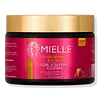What's inside
What's inside
 Key Ingredients
Key Ingredients

No key ingredients
 Benefits
Benefits

 Concerns
Concerns

 Ingredients Side-by-side
Ingredients Side-by-side

Water
Skin ConditioningGlycerin
HumectantPectin
Emulsion StabilisingHydrolyzed Corn Starch
HumectantPolysorbate 20
EmulsifyingXanthan Gum
EmulsifyingHydroxyethylcellulose
Emulsion StabilisingCarrageenan
Parfum
MaskingOrbignya Oleifera Seed Oil
EmollientMauritia Flexuosa Fruit Oil
Skin ConditioningCopaifera Officinalis Resin
MaskingAstrocaryum Murumuru Seed Butter
EmollientCocos Nucifera Oil
MaskingPunica Granatum Extract
AstringentPrunus Amygdalus Dulcis Oil
Skin ConditioningHoney
HumectantPersea Gratissima Oil
Skin ConditioningPhenoxyethanol
PreservativeBenzoic Acid
MaskingEthylhexylglycerin
Skin ConditioningGlycereth-2 Cocoate
EmulsifyingWater, Glycerin, Pectin, Hydrolyzed Corn Starch, Polysorbate 20, Xanthan Gum, Hydroxyethylcellulose, Carrageenan, Parfum, Orbignya Oleifera Seed Oil, Mauritia Flexuosa Fruit Oil, Copaifera Officinalis Resin, Astrocaryum Murumuru Seed Butter, Cocos Nucifera Oil, Punica Granatum Extract, Prunus Amygdalus Dulcis Oil, Honey, Persea Gratissima Oil, Phenoxyethanol, Benzoic Acid, Ethylhexylglycerin, Glycereth-2 Cocoate
Water
Skin ConditioningSodium C14-16 Olefin Sulfonate
CleansingCocamidopropyl Betaine
CleansingLaureth-5 Carboxylic Acid
CleansingSodium Chloride
MaskingCaprylyl/Capryl Glucoside
CleansingParfum
MaskingPEG-55 Propylene Glycol Oleate
Propylene Glycol
HumectantCitric Acid
BufferingHexylene Glycol
EmulsifyingSodium Benzoate
MaskingPotassium Hydroxide
BufferingPEG-40 Hydrogenated Castor Oil
EmulsifyingSalicylic Acid
MaskingPolyquaternium-67
Benzoic Acid
MaskingLimonene
PerfumingLinalool
PerfumingBertholletia Excelsa Seed Oil
EmollientButyrospermum Parkii Butter
Skin ConditioningCeramide AP
Skin ConditioningWater, Sodium C14-16 Olefin Sulfonate, Cocamidopropyl Betaine, Laureth-5 Carboxylic Acid, Sodium Chloride, Caprylyl/Capryl Glucoside, Parfum, PEG-55 Propylene Glycol Oleate, Propylene Glycol, Citric Acid, Hexylene Glycol, Sodium Benzoate, Potassium Hydroxide, PEG-40 Hydrogenated Castor Oil, Salicylic Acid, Polyquaternium-67, Benzoic Acid, Limonene, Linalool, Bertholletia Excelsa Seed Oil, Butyrospermum Parkii Butter, Ceramide AP
Ingredients Explained
These ingredients are found in both products.
Ingredients higher up in an ingredient list are typically present in a larger amount.
Benzoic Acid is used to preserve and adjust the pH of products.
The antimicrobial property of Benzoic Acid helps elongate a product's shelf life. Its main role is to reduce fungi growth and is not found to be effective at fighting bacteria. Therefore Benzoic Acid is always added along with other preservatives.
In its pure form, Benzoic Acid looks like a white crystalline solid. It has slight solubility in water.
The name of Benzoic Acid comes from gum benzoin, which used to be the sole source of deriving this ingredient. Benzoic Acid is the most simple aromatic carboxylic acid.
Benzoic Acid is naturally occuring in strawberries, mustard, cinnamon, and cloves. It has a slight scent but is not considered to be a fragrance.
Learn more about Benzoic AcidParfum is a catch-all term for an ingredient or more that is used to give a scent to products.
Also called "fragrance", this ingredient can be a blend of hundreds of chemicals or plant oils. This means every product with "fragrance" or "parfum" in the ingredients list is a different mixture.
For instance, Habanolide is a proprietary trade name for a specific aroma chemical. When used as a fragrance ingredient in cosmetics, most aroma chemicals fall under the broad labeling category of “FRAGRANCE” or “PARFUM” according to EU and US regulations.
The term 'parfum' or 'fragrance' is not regulated in many countries. In many cases, it is up to the brand to define this term.
For instance, many brands choose to label themselves as "fragrance-free" because they are not using synthetic fragrances. However, their products may still contain ingredients such as essential oils that are considered a fragrance by INCI standards.
One example is Calendula flower extract. Calendula is an essential oil that still imparts a scent or 'fragrance'.
Depending on the blend, the ingredients in the mixture can cause allergies and sensitivities on the skin. Some ingredients that are known EU allergens include linalool and citronellol.
Parfum can also be used to mask or cover an unpleasant scent.
The bottom line is: not all fragrances/parfum/ingredients are created equally. If you are worried about fragrances, we recommend taking a closer look at an ingredient. And of course, we always recommend speaking with a professional.
Learn more about ParfumWater. It's the most common cosmetic ingredient of all. You'll usually see it at the top of ingredient lists, meaning that it makes up the largest part of the product.
So why is it so popular? Water most often acts as a solvent - this means that it helps dissolve other ingredients into the formulation.
You'll also recognize water as that liquid we all need to stay alive. If you see this, drink a glass of water. Stay hydrated!
Learn more about Water